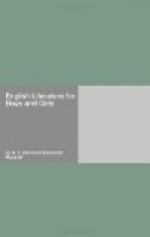That, in words such as we use now, is how Layamon begins his poem. But this is how the words looked as Layamon wrote them: —
“An preost wes on leoden: lazamon wes ihoten. he wes Leouenaoes sone: lioe him beo drihte.”
You can see that it would not be very easy to read that kind of English. Nor does it seem very like poetry in either the old words or the modern. But you must remember that old English poetry was not like ours. It did not have rhyming words at the end of the lines.
Anglo-Saxon poetry depended for its pleasantness to the ear, not on rhyme as does ours, but on accent and alliteration. Alliteration means the repeating of a letter. Accent means that you rest longer on some syllables, and say them louder than others. For instance, if you take the line “the way was long, the wind was cold,” way, long, wind, and cold are accented. So there are four accents in that line.
Now, in Anglo-Saxon poetry the lines were divided into two half-lines. And in each half there had to be two or more accented syllables. But there might also be as many unaccented syllables as the poet liked. So in this way the lines were often very unequal, some being quite short and others long. Three of the accented syllables, generally two in the first half and one in the second half of the line, were alliterative. That is, they began with the same letter. In translating, of course, the alliteration is very often lost. But sometimes the Semi-Saxon words and the English words are very like each other, and the alliteration can be kept. So that even in translation we can get a little idea of what the poetry sounded like. For instance, the line “wat heo ihoten weoren: and wonene heo comen,” the alliteration is on w, and may be translated “what they called were, and whence they came,” still keeping the alliteration.
Upon these rules of accent and alliteration the strict form of Anglo-Saxon verse was based. But when the Normans came they brought a new form of poetry, and gradually rhymes began to take the place of alliteration. Layamon wrote his Brut more than a hundred years after the coming of the Normans, and although his poem is in the main alliterative, sometimes he has rhyming lines such as “mochel dal heo iwesten: mid harmen pen mesten,” that is:—
“Great part they laid
waste:
With harm the most.”
Sometimes even in translation the rhyme may be kept, as:—
“And faer forh nu to
niht:
In to Norewaieze forh riht.”
which can be translated:—
“And fare forth now
to-night
Into Norway forth right.”
At times, too, Layamon has neither rhyme nor alliteration in his lines, sometimes he has both, so that his poem is a link between the old poetry and the new.




